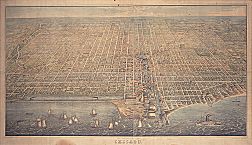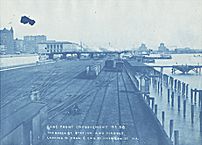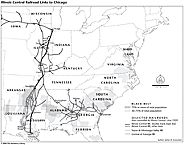| Entries |
| I |
|
Illinois Central Railroad
|

|
The IC completed its “Charter Lines” (705 miles in Illinois) in September 1856. The “Chicago Branch” (from Centralia to Chicago) opened a year earlier, giving that city its most important link to the South. The trunk of the railroad extended from the Mississippi River at Cairo northwest to the Mississippi opposite Dubuque, Iowa. The company founded dozens of new towns in Illinois and made “colonization work” (attracting settlers from Europe and other parts of the United States) part of its corporate strategy.

|
Throughout the twentieth century, the IC remained a conservatively managed, reasonably modern, and consistently profitable railroad with Chicago as its center of activity. In 1926 the railroad completed electrification of much of its freight and passenger service in the Chicago area. By World War II, the IC had spent over $65 million on improvements to its facilities in the region.

|
Loosened federal regulation in the 1980s permitted the railroad to again reinvent itself. Beginning in 1985, ICG sold nearly two-thirds of its railroad mileage in order to concentrate on the Chicago–New Orleans corridor. The company sold its Chicago commuter lines to Metropolitan Rail ( Metra ) in 1988. A year later, IC Industries spun off the rest of its railroad assets, which adopted the original “Illinois Central Railroad” name. The new IC was then purchased by New York's Prospect Group.
The Illinois Central Railroad profoundly affected the economic and physical development of Illinois and Chicago. It was the primary link between the Great Lakes and the Gulf of Mexico, providing access to the South for Chicago products and culture and a route north for millions during the “ Great Migration. ” In 1999 the Canadian National Railway acquired the IC, but its functions, routes, and franchise have remained important to Chicago's economy.
The Encyclopedia of Chicago © 2004 The Newberry Library. All Rights Reserved. Portions are copyrighted by other institutions and individuals. Additional information on copyright and permissions.